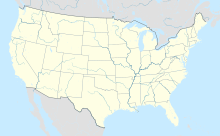Fort Dale facts for kids
Quick facts for kids Fort Dale |
|
|---|---|
| Greenville, Alabama in United States | |
| Coordinates | 31°53′42″N 86°39′15″W / 31.89500°N 86.65417°W |
| Type | Stockade fort |
| Site information | |
| Owner | Private |
| Controlled by | Private |
| Open to the public |
No |
| Site history | |
| Built | March 1818 |
| Built by | Alabama Territory settlers |
| In use | 1818-? |
Fort Dale was a fort made of tall wooden fences (called a stockade) built in what is now Butler County, Alabama. It was built by settlers living in the Alabama Territory. They built it to protect themselves from attacks by some Creek Native Americans.
Contents
Why Was Fort Dale Built?
After a big conflict called the Creek War, some Creek warriors, known as Red Sticks, were still in the area around Butler County. The Red Sticks were upset because many settlers were moving into their lands using the Federal Road. So, they started attacking the settlers.
To stay safe, settlers built small forts. One was built by Thomas Gary near what is now Greenville. Gary had a strong building called a blockhouse and asked people to pay to stay there.
On March 13, 1818, members of the Ogly and Stroud families were killed by Red Stick warriors. These warriors were led by a person named Uchee Tom. This event became known as the Ogly-Stroud Massacre. After this attack, settlers complained to the governor of the Alabama Territory, William Wyatt Bibb, about Gary charging fees.
In response, Governor Bibb sent Captain Samuel Dale and some soldiers from Fort Claiborne. Their job was to make Fort Bibb stronger and to build a brand new fort on the Federal Road.
The Story of Fort Dale
Building the Fort
While the new fort was being built, the people decided to name it Fort Dale to honor Captain Samuel Dale. The fort was built right on the Federal Road. It included a settler's cabin inside its walls. The fort's defenses were a wooden stockade and two blockhouses.
Just seven days after the Ogly-Stroud Massacre, a group of men left Fort Bibb to take a message to Captain Dale at the new fort. This group included Captain William Butler, William Gardender, James Saffold, Daniel Shaw, and John Hinson. On their way, they were attacked and killed by Red Sticks led by Savannah Jack. This sad event became known as the Butler Massacre. It made the settlers even more afraid. Because of this, more soldiers were sent from Fort Claiborne to help protect Fort Dale. Soldiers and their allies, the Choctaw warriors, also came from Fort Crawford to help find the Red Sticks.
Life at the Fort
While Fort Dale was still an active military post, an inn and a stagecoach stop were built there. This place was known as "The Palings." It got its name from the tall wooden fence (palisade) of Fort Dale. An English merchant named Adam Hodgson stayed at "The Palings" during his trip through North America. He described it as a "flourishing plantation," meaning a successful farm or settlement.
The Community Grows
Once the fort was no longer needed for protection, a community started to grow around the fort site. This community was first called Poplar Spring, but later it became known as Fort Dale.
Fort Dale was an important place. It served as the main town (county seat) for Butler County from 1819 to 1822. A post office opened at Fort Dale in October 1818, and John Herbert was the first postmaster. Fort Dale was also a stop on a postal route that went from Greenville to Hayneville. The community also had the first school and church in Butler County. It was one of the first places where people could vote.
A famous naturalist named William Bartram passed by the site of Fort Dale during his four-year journey through the Southern United States. He wrote about his travels in a book called Bartram's Travels.
What Remains Today?
Today, nothing is left of the original Fort Dale. However, the Fort Dale Cemetery is located near where the fort once stood. This cemetery is along Alabama State Route 185. In 1935, the cemetery was studied and recorded by the Historic American Buildings Survey. The oldest marked grave in Butler County is found in this cemetery. The Fort Dale Cemetery is also listed on the Alabama Register of Landmarks and Heritage, which means it's an important historical site.
Images for kids




